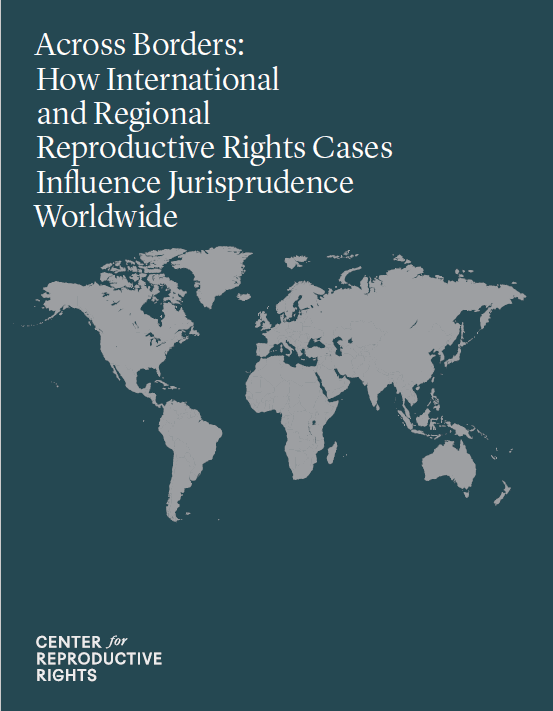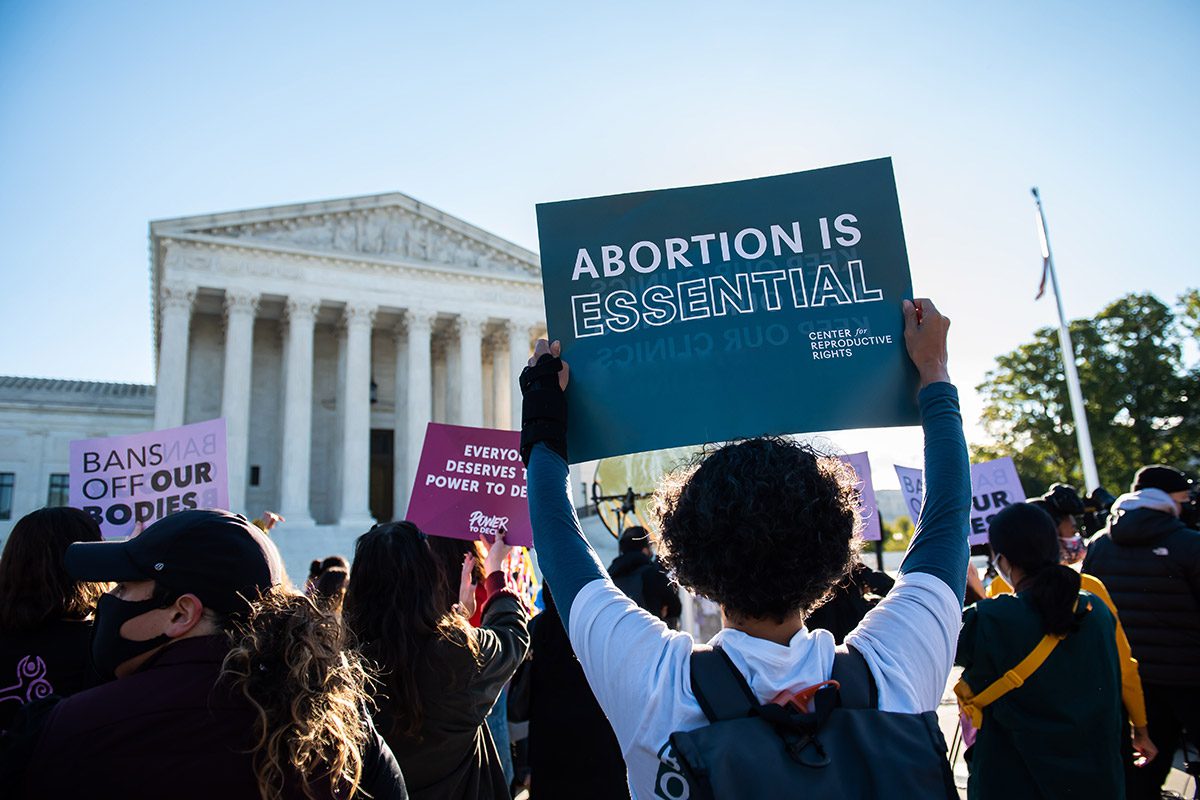
Influencing SRHR Law Across Borders
Groundbreaking Litigation Protecting and Advancing Sexual and Reproductive Health and Rights Around the Globe
A new report by the Center for Reproductive Rights analyzes the legal influence of six landmark cases before international and regional human rights bodies that have established lasting legal protections for reproductive autonomy—not only in the countries where the decisions were rendered, but across borders and regions.
Executive Summary
There is consensus around the world that sexual and reproductive health and rights (SRHR) are essential to gender equality, and yet millions of women and girls still lack legal protections for these fundamental rights. Strategic litigation to establish legal and policy reforms is critical to ensuring universal access to sexual and reproductive health services and to advancing and achieving gender equality.
Over the past two decades, the Center for Reproductive Rights, in partnership with local organizations, has brought groundbreaking litigation before international and regional human rights bodies to secure, protect and advance rights across a range of sexual and reproductive health issues, including abortion, maternal health care, and adolescents’ rights.
In a new report by the Center, titled Across Borders: How International and Regional Reproductive Rights Cases Influence Jurisprudence Worldwide, you’ll learn how a handful of these landmark cases has established lasting legal protections that have been relied upon time and again to further protect the decision-making and reproductive autonomy of women and girls not just in the countries where the decisions were rendered, but across borders and regions.
These landmark rulings—some in countries and regions with the most restrictive reproductive rights laws—have advanced access to abortion services, maternal health care, assisted reproduction and other reproductive and human rights. The accompanying maps demonstrate the cascading and lasting effects of these landmark cases.
The Cener launched the report at a January 26 webinar with global experts. (Watch a replay of the webinar here.)
Below are highlights of three of the six case studies examined in the full report.
Download the report’s executive summary or the full report.
Case Study: K.L v. Peru (U.N. Human Rights Committee, 2005)
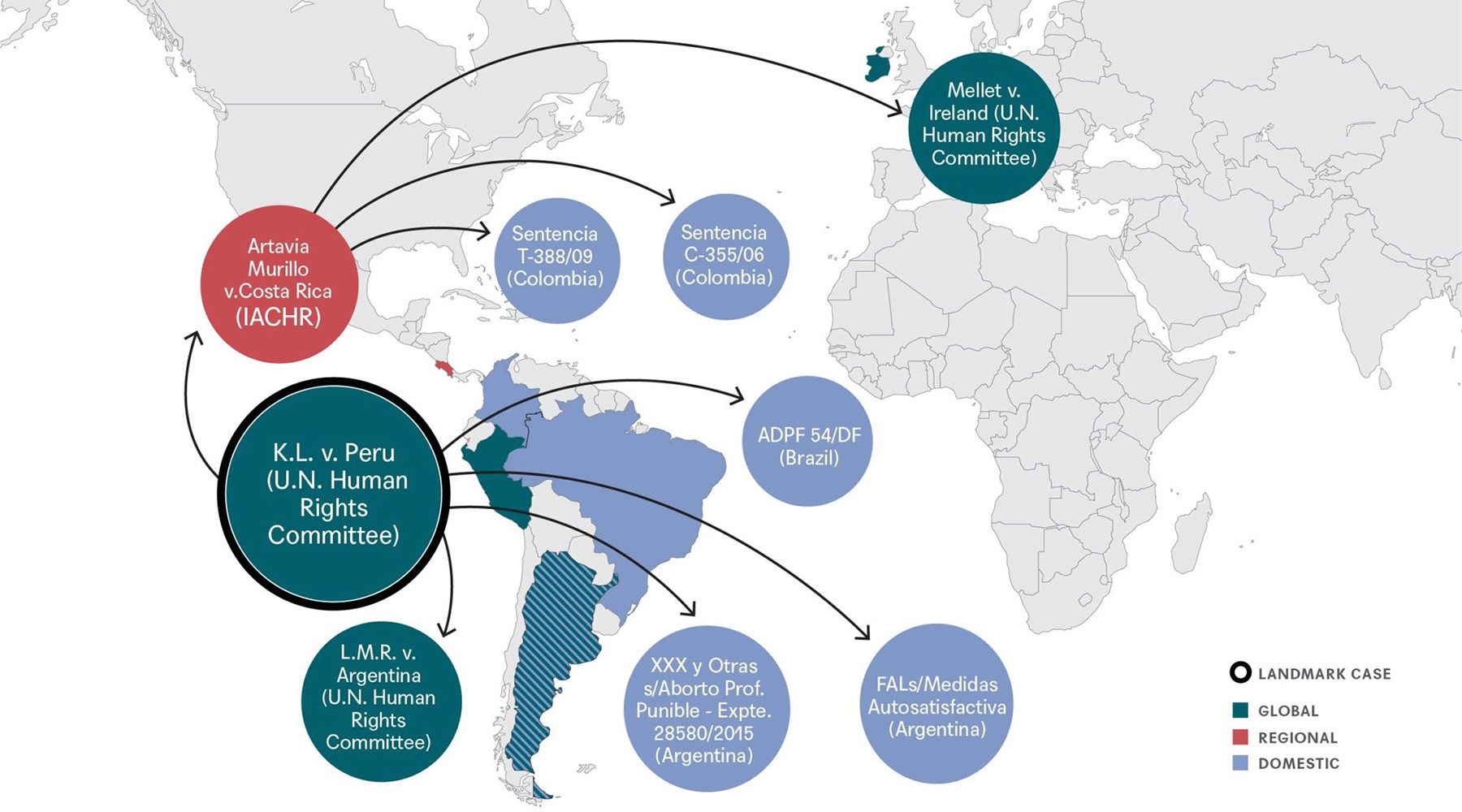
K.L. v. Peru influenced decisions from global and regional human rights bodies and courts in Argentina, Brazil, and Colombia. Click image to enlarge.
When our client K.L. was 17, she learned she was carrying a pregnancy with a fatal fetal impairment. By law in her homeland of Peru, she was entitled to an abortion due to the risk the pregnancy posed to her physical and mental health. Because hospital authorities refused her access to an abortion, she was forced to carry the pregnancy to term, and as expected, the baby died several days later. The United Nations Human Rights Committee issued a groundbreaking decision in K.L. v. Peru , recognizing that denial of abortion services violated her rights to privacy and freedom from cruel, inhuman, and degrading treatment, among others. Critically, the U.N. Human Rights Committee made clear that where abortion is legal, it must be accessible in practice.
While this case—brought the Center in partnership with the Latin American and Caribbean Committee for the Defense of Women’s Rights (CLADEM) and the Counseling Center for the Defense of Women’s Rights (DEMUS) — centered on Peru’s abortion law, its lasting effects have reverberated across borders. The highest courts in Argentina, Brazil, and Colombia all relied on the decision in K.L. v. Peru in their own landmark cases liberalizing restrictive abortion laws in those countries. These decisions have resulted in stronger legal protections and accessible rights for millions of women and girls. Lower courts have also relied on this case, including one in Colombia that affirmed a woman’s right to an abortion in another fatal fetal impairment case.
More recently, K.L. was also instrumental in recognizing that individuals have a right to access in vitro fertilization and that prenatal interests cannot trump the rights of individuals. This decision, in Artavia Murillo et al. v. Costa Rica, came from the Inter-American Court of Human Rights – which sets standards for countries across the Americas – and has great potential to further influence protections for abortion, contraception, and a range of other issues across the region. Additionally, the U.N. Human Rights Committee, in Mellet v. Ireland, has affirmed and built on the K.L precedent to further recognize that the prohibition and criminalization of abortion violates fundamental human rights.
Case Study: Alyne v. Brazil (U.N. Committee on the Elimination of Discrimination Against Women, 2011)
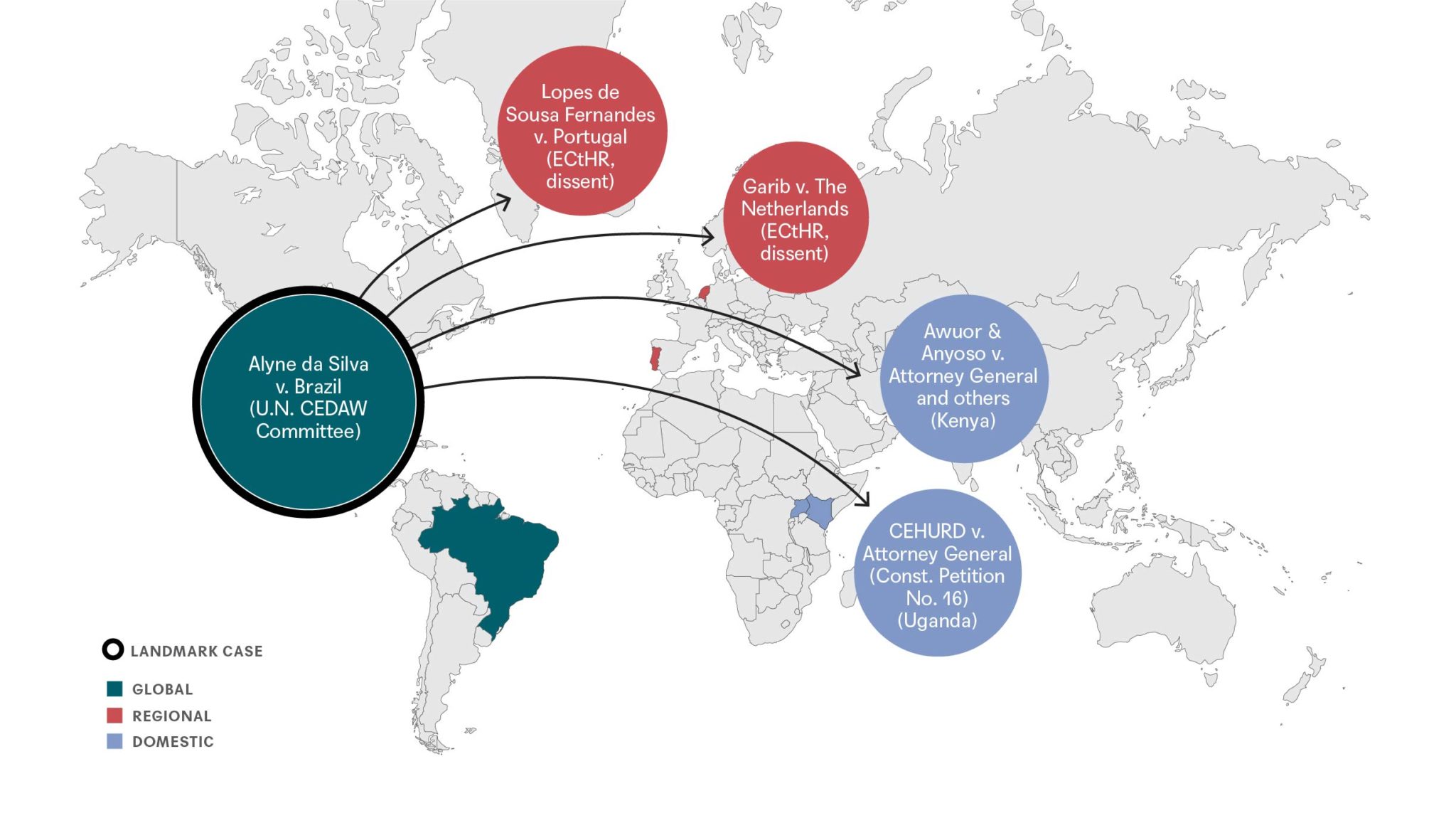
Alyne v. Brazil influenced decisions from the European Court of Human Rights and courts in Kenya and Uganda. Click image to enlarge.
Alyne, a poor Afrobrazilian woman, was repeatedly denied appropriate emergency obstetric care, ultimately leading to her death from preventable causes after experiencing a miscarriage. In an unprecedented decision, the United Nations Committee on the Elimination of Discrimination Against Women (CEDAW) recognized in Alyne v. Brazil that states must ensure the provision of timely, quality maternal health care to all women, regardless of race or income, and that it is insufficient for states to take measures to improve maternal health which neglect marginalized sectors of the population.
The impact of the decision in this case —brought by the Center and Brazilian partner Citizens’ Advocacy for Human Rights (ADVOCACI) — has reverberated across borders. In a case in Kenya, the decision in Alyne was critical to the court recognizing serious human rights violations stemming from the detention of women for the inability to pay their maternity bills. In Uganda, a court relied on the standards created in Alyne to hold the Ugandan government accountable for failing to provide adequate maternal health services, including emergency obstetric care. Additionally, in two dissents from the European Court of Human Rights, judges looked to Alyne in calling on the Court to take a firmer stance in holding states accountable for discrimination and medical negligence.
Case Study: P. and S. v. Poland (European Court of Human Rights, 2012)
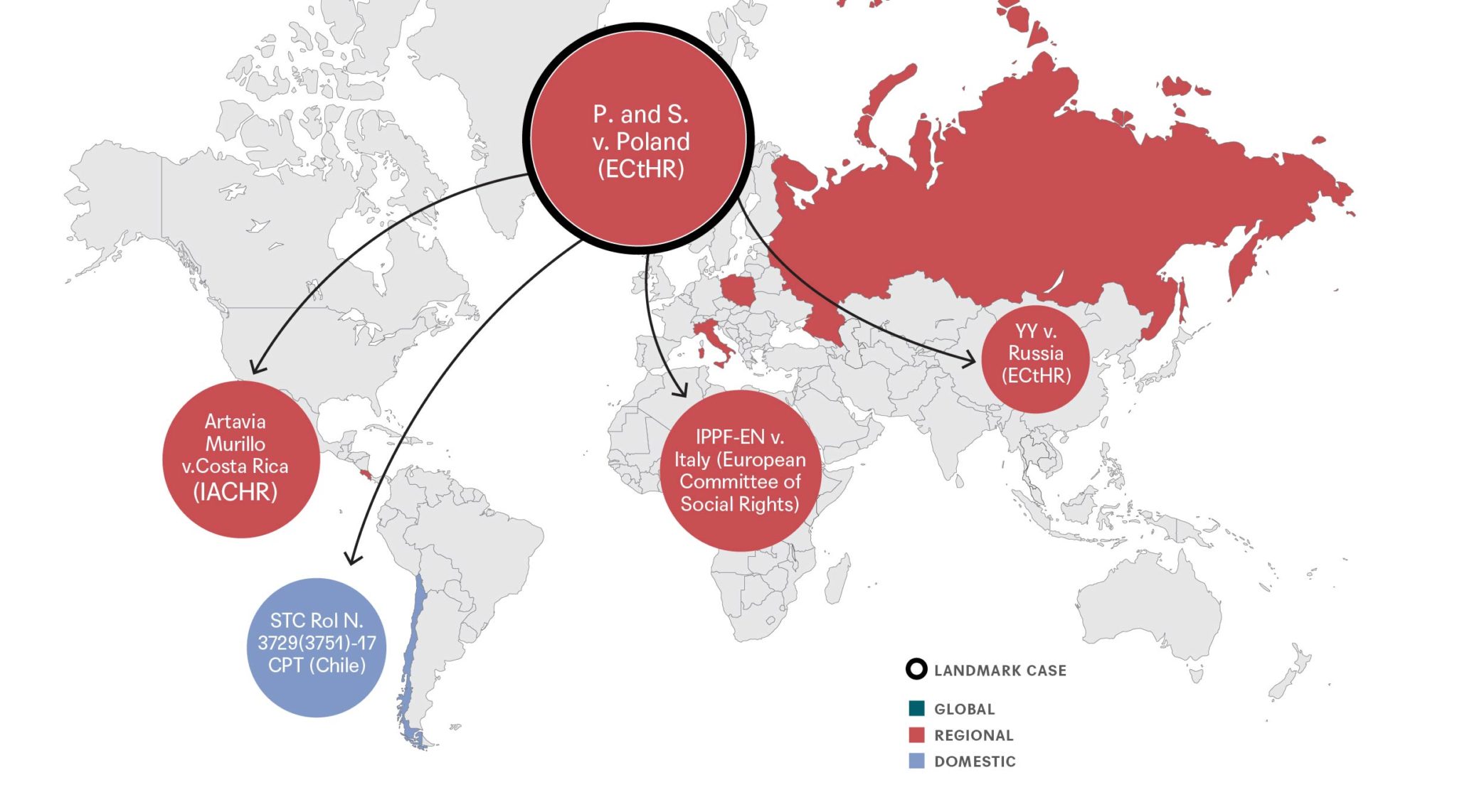
P. and S. v. Poland influenced decisions from regional human rights bodies and in Chile. Click image to enlarge.
In P. and S. v. Poland, the European Court of Human Rights issued a groundbreaking decision recognizing obstructing access to legal abortion services and violations of medical confidentiality can amount to violations of the right to be free from cruel, inhuman and degrading treatment and the right to respect to private life, among other rights. In this case, P., who was 14 years old at the time, sought abortion services after becoming pregnant from a sexual assault, but encountered numerous obstacles, including doctors’ refusal to provide abortion services, hospital staff repeatedly providing her and her mother with deliberately distorted information, the release of her personal and medical data to the press, and harassment by doctors, anti-abortion groups, and representatives of the Catholic Church. At one point P. was removed from her mother’s custody and detained in a juvenile center.
The decision in this case —brought by the Center and the Reproductive Rights Legal Network of Polish Federation for Women and Family Planning—has influenced domestic and regional courts across the globe. In overturning a ban on in vitro fertilization, the Inter-American Court of Human Rights – whose decisions impact the entire Latin America and Caribbean region – looked to P. and S. in recognizing the critical importance of decisions about whether to become a parent.
The European Court of Human Rights relied on P. and S. in recognizing the protection of medical data as crucial to patients’ privacy and their confidence in the medical system. And multiple courts and human rights bodies have looked to P. and S. in affirming that where abortion is legal, it must be accessible in practice. This includes in Chile, where P. and S. influenced the Constitutional Court to affirm a law prohibiting institutions from refusing to provide abortion on the grounds of conscience or religion. This measure is critical to ensuring that abortion is not just a right on paper, but also in practice.
Three additional landmark case studies are profiled in the full report. Download the full report below and explore these influential cases and how they influenced SRHR law across the globe:
The Full Report: “Across Borders: How International and Regional Reproductive Rights Cases Influence Jurisprudence Worldwide”
The Center’s new report, Across Borders: How International and Regional Reproductive Rights Cases Influence Jurisprudence Worldwide, tracks the legal influence of six international and regional landmark cases over time, illuminating and underscoring how successful litigation can transform law on SRHR. The report documents how these cases have become the foundation for establishing legal protections for women and girls’ reproductive autonomy and decision-making far beyond the countries where they were originally filed. Courts from across the globe have relied on these landmark cases to build and strengthen legal standards of their own.
These landmark rulings have advanced access to abortion services, maternal health care, assisted reproduction and other reproductive and human rights.
Read the full report and explore all six influential cases in-depth.
Global Litigation Map
This map, featured in the report, illustrates how six landmark reproductive rights cases have influenced courts and human rights bodies throughout the world. The legal precedents established by the rulings in these cases have had far-reaching impacts in securing, protecting and advancing abortion, maternal health care, assisted reproduction, adolescents’ rights, and other SRHR issues. (Click the image to enlarge or view it full sized in the report here.)
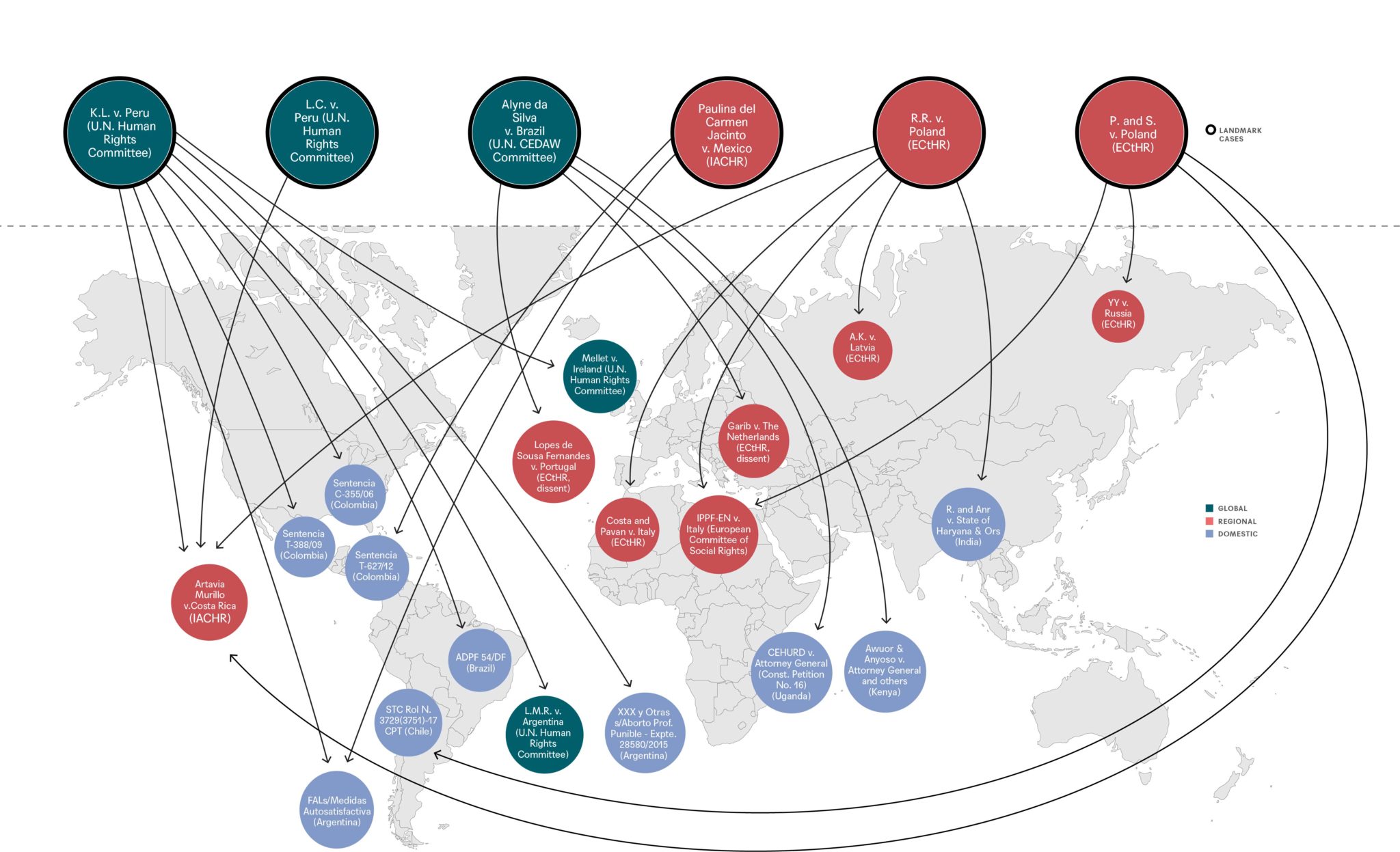
“Strategic litigation to establish legal and policy reforms is critical to ensuring universal access to sexual and reproductive health services and to advancing and achieving gender equality.”
